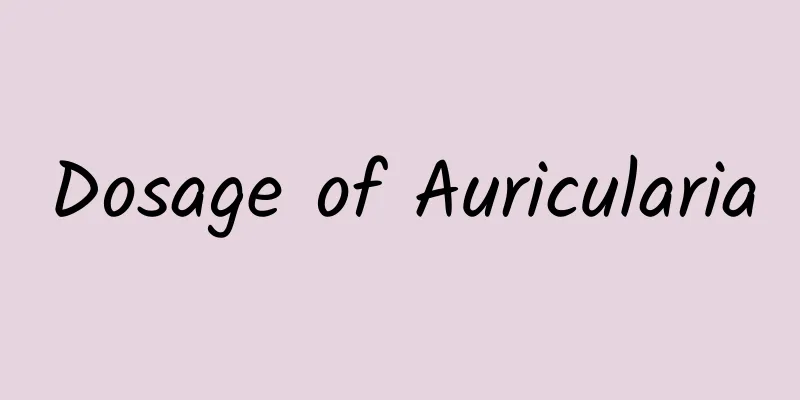Dosage of Auricularia

|
We often call stone fungus stone wood ear and rock mushroom or navel fungus and stone wall flower. Stone ear grows in the damp crevices of cliffs. Because it looks very much like an ear, it is named stone ear. Stone ear has therapeutic benefits in health preservation and also has medicinal functions. Stone ear can moisten the lungs and cool the blood, and can clear away heat and detoxify the human body. Below we carefully analyze the medicinal value and dosage of stone ear. The medicinal functions of stone ear are very comprehensive. It can protect the blood system and promote the immune system. It can promote the synthesis of nucleic acid and protein, resist blood lipids and prevent atherosclerosis, resist aging and lower blood sugar. The lichen body is monolithic, perfectly round when young, and becomes oval or slightly irregular when grown up, with a diameter of about 12 cm, and the largest can reach 18 cm, and is leathery. The edges of the lobes are shallowly torn; the upper surface is brown, nearly smooth, partially rough and dull, or partially spots fall off to reveal the white pith; the lower surface is brown-black to black, with fine granular protrusions, densely covered with black, thick, short and forked rhizomes, the central hilum is blue-gray to black, with a diameter of 5-12mm, and sometimes the veins radiating from the hilum to the surrounding areas are obvious and prominent. Ascocarp is rare. Medicinal value Traditional Chinese Medicine Discussion Functions and indications: Nourishes yin and moistens the lungs; cools blood and stops bleeding; clears away heat and detoxifies. It is used to treat cough due to lung deficiency, vomiting blood, epistaxis, metrorrhagia, intestinal bleeding, hemorrhoidal fistula, rectal prolapse, stranguria, leucorrhea, snake bites, burns and knife wounds. Western medicine discussion 1. Impact on the blood system (1) Anticoagulant effect 300% Auricularia auricula decoction 1ml/100g was administered intragastrically for 20 drops continuously. The experimental results showed that Auricularia auricula could prolong the partial thromboplastin time of white clay by 12.06s, increase the activity of plasma antithrombin III, and have a significant anticoagulant effect. The intravenous injection, intraperitoneal injection and oral gavage of 50 mg/kg of Pyricularia auriculariae polysaccharide to mice all had obvious anticoagulant effects; in in vitro experiments, Pyricularia auriculariae polysaccharide also had strong anticoagulant activity. (2) Antiplatelet aggregation effect The phosphate-buffered saline extract of Pyricularia auricularia significantly inhibits ADP-induced platelet aggregation in a test tube and blocks the release of 5-hydroxytryptamine from platelets activated by ADP below 16 μmol/L. The active ingredient of Pyricularia auricularia's antiplatelet effect is water-soluble. After taking 70g of Auricularia auricularia orally, people begin to experience a decrease in platelet function within 3 hours and the decrease lasts for 24 hours. The acid extract of Auricularia auricularia mycelium can significantly inhibit ADP-induced platelet aggregation in rats in vivo (10g/kg intravenous injection or 10g/kg gavage for 15 consecutive days in rats) and in vitro (25mg/ml, 50mg/ml and 100mg/ml (mycelium)). Oral administration of 5g/kg and 7g/kg of the alcohol extract for 15 days can significantly shorten the electrophoresis time of red blood cells. The results of intraperitoneal injection test of Auricularia auriculariae acidic heteropolysaccharide in mice showed that the polysaccharide has the effects of promoting leukocyte increase, anticoagulation and reducing platelets, and its activity increases with the decrease of polysaccharide molecular weight and uronic acid content, that is, the biological activity depends on the solubility of the polysaccharide in water. (3) Anti-thrombotic Oral administration of 18.5 mg/kg of Pyricularia auricularia polysaccharide to rabbits can significantly prolong the formation time of specific thrombus and fibrin thrombus, shorten the length of thrombus, reduce the wet weight and dry weight of thrombus, reduce the number of platelets, reduce the platelet adhesion rate and blood viscosity, and significantly shorten the euglobulin dissolution time of guinea pigs, reduce plasma fibrinogen content, and increase plasmin activity. The results show that Pyricularia auricularia polysaccharide has a significant anti-thrombotic effect. (4) Leukocyte-raising effect Intraperitoneal injection of 2 mg/mice with Pyrrolidone polysaccharide for 7 consecutive days had a good effect in counteracting the leukocytopenia caused by cyclophosphamide. 2. Promoting immune function Auricularia auricularia polysaccharide can increase the spleen index, half hemolytic value (HC50) and rosette formation rate of mice, promote macrophage phagocytosis and lymphocyte transformation, etc. Intraperitoneal injection of 250 mg/kg of Auricularia auriculariae mycelium into mice for 7 consecutive days can significantly increase the percentage of peripheral blood T lymphocytes; subcutaneous injection of 400 mg/kg and 800 mg/kg for a total of 7 days can reduce the half hemolysis value HC50 caused by cyclophosphamide and return to normal. 3. Effects on nucleic acid and protein biosynthesis 100 μg of Pyricularia auricula polysaccharide has a significant promoting effect on the synthesis of deoxyribonucleic acid and RNA in human lymphocytes. When 100 mg/kg of Auricularia auricularia polysaccharide was injected intraperitoneally into mice for 4 consecutive days, it had a weak promoting effect on the incorporation of 3H-leucine into mouse serum proteins. 4. Effects of lowering blood lipids and preventing atherosclerosis Continuous oral administration of 30 g/kg of Auricularia auricula decoction for 20 days and 28 mg/kg of Auricularia auricula polysaccharide for 8 days can significantly reduce the levels of serum triglycerides (triglycerides) and total cholesterol (TC) in hyperlipidemic rats, increase the ratio of serum high-density lipoprotein cholesterol (HDL-C) to total cholesterol, and have a cholesterol-lowering effect. Oral administration of 180 mg/kg of Auricularia polysaccharide can prevent the formation of hypercholesterolemia in mice caused by high cholesterol. When feeding cholesterol and adding 2.5 g of Pyralidium to rabbits daily for 90 days, it can reduce the levels of plasma cholesterol, lipid peroxide (LPO), and thromboxane A2 (TXA2) in rabbits, increase the ratio of prostacyclin/thromboxane A2 (PGI2/TXA2), and alleviate atherosclerosis. 5. Anti-aging effect Giving rabbits 2.5g of Pyralis truncatula daily for 90 days can reduce the levels of oxygen free radicals, lipofuscin in liver, heart and brain tissues, plasma lipid peroxides, and plasma cholesterol in rabbits with atherosclerosis, and alleviate the effects of atherosclerotic lesions. It is suggested that Auricularia auricula may lower plasma cholesterol and reduce the formation of lipid peroxidation product lipofuscin to maintain normal cell metabolism and show anti-aging effect. Using chemiluminescence analysis, the scavenging effect of 50μl, 800μl, and 1000μl of 2.5% Pyricularia auricula water extract on H2O2 or superoxide radicals (O-2) produced by enzyme systems and non-enzymatic systems was studied. The scavenging ability showed a dose-effect relationship with the dosage, indicating that the Pyricularia auricula water extract contains ingredients with antioxidant effects. Intraperitoneal injection of 100 mg/kg of Auricularia auriculariae polysaccharide for 7 consecutive days can prolong the average swimming time of mice in water by 50.40%, and enhance the anti-fatigue ability of mice; it can also significantly reduce the lipofuscin content in the myocardial tissue of mice; it can significantly increase the specific activity of superoxide dismutase (SOD) in the brain and liver tissue of mice; it has a significant inhibitory effect on the activity of monoamine oxidase B (MAO-B) in the isolated brain of mice, and the inhibitory intensity increases with the increase of concentration, and it can increase the flying ability of fruit flies. Pyricularia auricularia polysaccharide can significantly prolong the average lifespan of fruit flies, which is 1.26 times that of the control group. After oral administration of Pyricularia auricularia polysaccharide for 40 days, the lipofuscin content of fruit flies was reduced. 6. Anti-radiation and anti-inflammatory effects Intraperitoneal injection of 100 mg/kg of Auricularia auriculariae polysaccharide into mice for 7 consecutive days had an antagonistic effect on 60Co γ-ray irradiation, increasing the survival rate of mice by 1.56 times. Intraperitoneal injection of 60 mg/mouse had a certain anti-inflammatory effect on plantar swelling caused by egg white in rats. 7. Anti-ulcer effect Daily oral administration of 70 mg/kg of Pyricularia polysaccharide for 2 consecutive days can significantly inhibit the formation of stress ulcers in rats; daily oral administration of 165 mg/kg for 12 consecutive days can promote the healing of acetic acid-type gastric ulcers, and has no significant effect on gastric acid secretion and pepsin activity. 8. Hypoglycemic effect Oral administration of 33mg/kg or 100mg/kg of Auricularia auricula polysaccharide can significantly reduce the blood sugar level of alloxan diabetic mice. The blood sugar lowering effect is most significant 4 to 7 hours after oral administration of the polysaccharide. It can also reduce the amount of water consumed by diabetic mice. 9. Anti-fertility effect When 8.25 mg/kg of Auricularia auricularia polysaccharide was injected intraperitoneally into mice, it had the most obvious anti-implantation and anti-early pregnancy effects, with a slightly weaker effect on terminating mid-term pregnancy, but it was ineffective for the transportation of fertilized eggs. 10. Anti-cancer and anti-mutation effects The inhibition rate of hot water extract of Pyrola rugosa on Swiss mouse sarcoma S180 is 42.5% to 70%, and the inhibition rate on Ehrlich ascites carcinoma is 80%. Administration of Pyricularia auriculariae polysaccharide at a dose of 200 mg/(kg·d) for 10 consecutive days had an effect on counteracting the increase in the micronucleus rate in the bone marrow of mice induced by cyclophosphamide. 11. Antibacterial effect: The blackthorn toxin isolated from Auricularia auricula has antifungal effect. 12. The LD50 of toxic Auricularia auriculariae polysaccharide injected intraperitoneally in mice is 789.60±92.19 mg/kg. In the above article, we introduced what stone ear is. Stone ear is also known as stone wood ear. We also introduced the dosage of stone ear. In daily life, stone ear has the effect of health preservation and diet therapy. The medicinal value of stone ear is very high. It can protect the blood system, promote the immune system, and is beneficial to the synthesis of nucleic acid and protein. Moreover, stone ear can resist aging and lower blood sugar in the human body. It is worthy of our choice of health preservation and diet therapy. |
<<: Side effects of bitter beans
>>: Medicinal Value of Artichoke
Recommend
Energy conservation without loss? Is South Korea's discovery of "room temperature superconductivity" reliable this time?
A team of physicists from South Korea recently up...
A new landmark in Antarctica! Qinling Station has a “Chinese style”
On February 7, General Secretary Xi Jinping sent ...
The efficacy and function of Alpinia officinalis
Alpinia serrulata has rich nutritional value and ...
It is very dangerous to dig wild vegetables by yourself, be careful of poisoning and being admitted to the ICU!
Nowadays, many people pursue "original ecolo...
The efficacy and function of honeycomb ganoderma
Bees are magical creatures that provide many good...
The efficacy and function of sword-leaved Ardisia
In today's society, health preservation seems...
What medicine is effective for tonsillitis?
Many people have experienced symptoms of tonsilli...
How did ordinary garlic become the anti-cancer "warrior" among condiments?
Audit expert: Wang Guoyi Postdoctoral fellow in N...
The efficacy and function of ground bamboo shoots
Ground shoots are a kind of traditional Chinese m...
Chinese medicine Melia azedarach
Melia azedarach is a kind of fruit that many frie...
The efficacy and function of Burmese jujube
In today's society, health preservation seems...
[Smart Farmers] When "rice" meets "fishing", exploring the various possibilities of ecological agriculture
When "rice" meets "fishing", ...
Why does urine turn yellow when drinking less water?
Maybe everyone has noticed that sometimes when yo...
Can I get pregnant with hyperthyroidism?
Hyperthyroidism is a common thyroid disease, whic...
Fever myths: How high a fever can damage the brain? The truth is…
You must have heard others say A child's feve...









